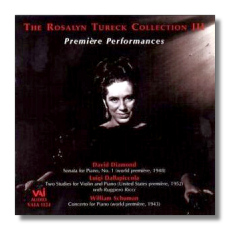
The Internet's Premier Classical Music Source
Related Links
- Latest Reviews
- More Reviews
-
By Composer
-
Collections
DVD & Blu-ray
Books
Concert Reviews
Articles/Interviews
Software
Audio
Search Amazon
Recommended Links
Site News
 CD Review
CD Review
The Rosalyn Tureck Collection

Volume 3, Première Performances
- David Diamond: Piano Sonata #1
- Luigi Dallapiccola: Two Studies for Violin & Piano *
- William Schuman: Piano Concerto (revised 1942)
Rosalyn Tureck, piano
* Ruggiero Ricci, violin
Saidenberg Little Symphony Orchestra/Daniel Saidenberg
VAI VAIA1124 62:26
Summary for the Busy Executive: That girl can play.
These days, we tend to think of Tureck as a Bach specialist, and I suspect at least some of us mistrust this exclusivity. After all, Bach doesn't provide the Romantic keyboard pyrotechnique of a Liszt or a Rachmaninoff, and there was indeed a relatively prominent Mozartean who simply hadn't the fingers to perform anyone else. We forget that at the outset of her career, Tureck played everything – Beethoven, Chopin, the operatic paraphrases of people like Godowsky – the stuff of the young virtuoso in the Thirties and Forties. She also played her share of then-contemporary music. Typical of Tureck, contemporary music was not simply the way to get noticed, before one then had the career security to settle into a lifetime of "safe" programming. She strongly believed in performers and composers talking to each other and founded at least one concert series devoted to contemporary music. Besides, Tureck didn't need to get noticed. People noticed her. Diamond composed the magnificent piano sonata heard on this CD uncommissioned and unasked, simply because Tureck's playing inspired him. As William F. Buckley remarked, the only thing wrong with Tureck's dedication to Bach was that it deprived us of her Brahms and Chopin. Now VAI Audio has released at least three CDs documenting Tureck's earlier career, and we can hear for ourselves what the clamor was about.
The best work on the CD – for me, the Diamond – belongs to that somewhat obscure category, the American Piano Sonata. With the exceptions of the Ives Second, the Griffes, the Barber, and the Carter, I can't think off the top of my head of anything approaching the status of repertory classic. The Diamond and the Talma Second would, in a better world, be better known. Both set out for the monumental and pretty much hit what they aim at. Diamond has acknowledged the influence of the late Beethoven sonatas, and one can easily see the resemblances to the Op. 110, with Diamond's conflation of two movements in one and extended fugue. Diamond gives us, in fact, two fugues, one as the peroration of the first movement and the second (a double fugue) a summing up of the entire sonata. The composer had counted Tureck's Bach recitals among his best concert experiences, and when he began the sonata with Tureck in mind, the one thing he knew for sure was that there would be a fugue. The entire sonata alternates between the declamatory and the contrapuntal. Tureck plays the bejabbers out of it – a huge tone that "calls the meeting to order" and a panoply of "touch." As with her Bach playing, you have the feeling that she can emphasize any line she wishes and that she has decided to bring out the structurally most important ones. The recording makes it clear that Tureck has absorbed the work into her bones; it is assured, free, and powerful. Tureck's performance lets a première sound like an instant classic – an account at a level most composers would sell their souls for. Diamond must have been thrilled.
I love Dallapiccola's music in general. My enthusiasm doesn't extend to this particular piece. It is obviously composed by a master musician, but it seems all too foursquare to me, particularly the fugal second movement. Of course, a monochromatic realization by Ricci doesn't help. Tureck does fine, but, again, the piece doesn't really grab me.
William Schuman's piano concerto is a lot of fun, but it's not a major piece in his catalogue. In the decades following its 1943 première (this performance), he himself almost had forgotten about it. It took an account by Gary Steigerwalt in 1978 to remind the composer and to inspire him to write more piano music. Tureck has power without banging and overwhelms the poor orchestra. She's got the piece under her belt. The orchestra is a bit ragged and hesitant and seems almost to fake certain passages. In short, I wouldn't get this CD for the Schuman unless you're a Tureck fan or a Schuman headbanger, for this seems to be the only recording currently available. If you simply want to explore, I'd wait until a better orchestra tackles it.
We have essentially acetates from Tureck's private vault. I don't believe any of these recordings were intended for commercial release. The sound is, of course, mono throughout. It's acceptable in the Diamond and in the Dallapiccola, too deteriorated in the Schuman.
Copyright © 2001, Steve Schwartz


















